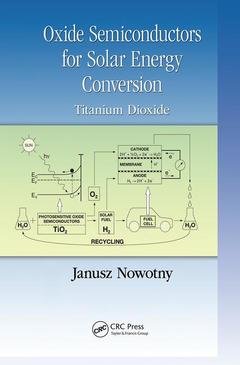Oxide Semiconductors for Solar Energy Conversion Titanium Dioxide Green Chemistry and Chemical Engineering Series
Auteur : Nowotny Janusz

Oxide semiconductors, including titanium dioxide (TiO2), are increasingly being considered as replacements for silicon in the development of the next generation of solar cells. Oxide Semiconductors for Solar Energy Conversion: Titanium Dioxide presents the basic properties of binary metal oxide semiconductors and the performance-related properties of TiO2 as they relate to solar energy.
The book provides a general background on oxide semiconductors based on binary oxides and their solid solutions, including electronic and ionic conductors. It covers several aspects of solid-state electrochemistry of oxides, such as defect chemistry, and defect-related properties, such as electrical properties, diffusion, segregation, and reactivity. The author also takes a pioneering approach in considering bulk versus surface semiconducting properties, showing how they are different due to the effect of segregation.
One of the first on semiconducting, photocatalytic, and photoelectrochemical properties of TiO2 and its solid solutions with donor- and acceptor-type ions, the book discusses defect chemistry of TiO2 in terms of defect equilibria and defect-related properties, including electrical properties, self and chemical diffusion, surface properties, segregation, and reactivity and photoreactivity with oxygen, water, and microbial agents. The text also illustrates the use of TiO2 as an emerging material for solar energy conversion systems, including the generation of hydrogen fuel by photoelectrochemical water splitting, the photocatalytic purification of water, and the generation of photovoltaic electricity. In addition, it presents defect disorder diagrams for the formation of TiO2-based semiconductors with controlled properties.
Encompassing the areas of solid-state science, surface chemistry, and photocatalysis, this book reflects the increasing awareness of the importance of structural imperfections, such as point defects, in understanding the properties of metal oxides, specifically TiO2-based semiconductors.
Solid-State Electrochemistry of Binary Metal Oxides. Light-Induced Effects. Basic Properties of TiO2. Defect Chemistry. Electrical Properties. Diffusion. Effect of Interfaces. Applications. Appendix. Index.
Janusz Nowotny is a professor of solar energy technologies at the University of Western Sydney. He has been a recipient of the Sir William Grove Award of the International Association for Hydrogen Energy and the Pfeil Award of the Institute of Materials, Minerals and Mining in London. Dr. Nowotny was the director of a NATO Advanced Research Workshop on Nonstoichiometric Compounds — Surfaces, Grain Boundaries and Structural Defects. He was also the founder and co-organizer of two series of International Workshops: Nonstoichiometric Compounds and Ceramic Interfaces.
Date de parution : 03-2017
15.6x23.4 cm
Date de parution : 10-2011
Ouvrage de 392 p.
15.6x23.4 cm
Thèmes d’Oxide Semiconductors for Solar Energy Conversion :
Mots-clés :
Defect Disorder; Titanium Vacancies; Oxide Semiconductors; American Chemical Society; Titanium Dioxide; Nb Doped TiO2; Solar Energy Conversion; GRAIN BOUNDARY; solar materials; Ti Ti; defect chemistry; TiO2 Single Crystal; photocatalysis; GRAIN BOUNDARY DIFFUSION; TiO2-based semiconductors; Res Rep; hydrogen fuel; Outermost Surface Layer; photoelectrochemical water splitting; Undoped TiO2; photocatalytic purification of water; Thermoelectric Power; photovoltaic electricity; Water Splitting; solid-state science; Cr Doped TiO2; surface chemistry; Phys Chem; semiconducting properties; Electronic Charge Carriers; Materials Science; Oxygen Activity; Chemical Diffusion; Oxygen Vacancies; Solar Energy; Charge Transport; Electrical Conductivity Data; Polycrystalline TiO2; Thermoelectric Power Data



